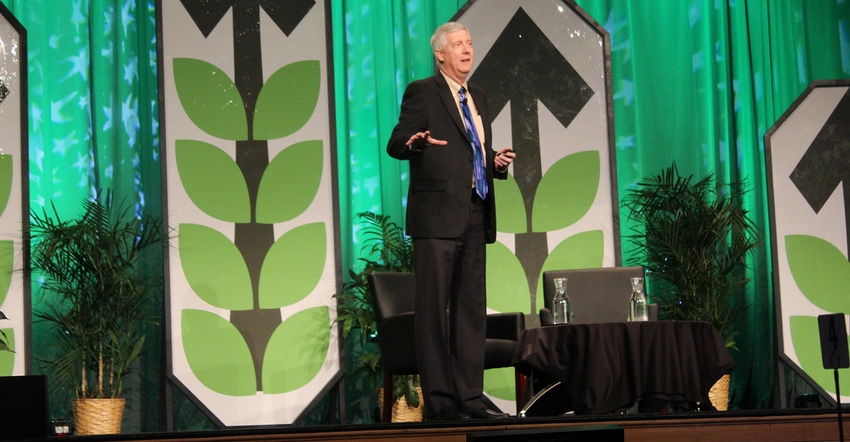
One might think an agricultural economist would leave the audience with numbers to remember following a keynote address. However, Michael Swanson, Wells Fargo ag economist and senior vice president, says people don’t remember the numbers, they remember the stories.
“I have a different approach to economics,” Swanson said in his presentation before the Minnesota AgriGrowth Council annual meeting Nov. 9 at the Minneapolis Convention Center. “I’m not here to overwhelm you with the numbers. I don’t think the numbers are always that important. I want to talk about the connections, because I really think one of the things that we fail to do in economics and do well in a lot of analysis is think about the systems. Systems are about how things interact.”
Here are seven highlights from Swanson’s speech.
1. Corn. The longest continuous data series maintained by the U.S. government is the price of corn. The government has corn price data going back to 1867.
There’s a trend over the past 100 years, but as often found in time series charts, there are also cycles, seasonality and random noise.
Corn prices today are definitely higher than they were a couple of hundred years ago, Swanson said. The price of corn moves in steps, with trends around the stair steps and a lot of random noise.
2. Farm financials. USDA issues its farm financial numbers a couple of times a year. From 1990 to 2004, farm income was stuck around $90 billion. With the biofuels decision, there was an increase in crop revenue, which was about $190 billion in the latest USDA report. Livestock income, on the other hand, was challenged by the increase in crop prices. Livestock revenues were about $165 billion in the latest USDA report.
Net farm income declined from 2014 to 2016 and may be turning the corner in 2017, with USDA forecasting NFI will increase 1.5% this year.
In Minnesota, though, it’s tough out there, Swanson said, with more volatility than the national outlook because of the state’s unique agricultural makeup. Crop production is slightly bigger than livestock production in the state.
3. Grain vs. oilseeds. From 1961 to 2014, there’s been no change in grain acreage around the globe, but there’s been real change in oilseed production, according to data from the United Nations Food and Agriculture Organization.
Every year from 1961 to 2014, there’s been 1.8% more oilseed acreage, Swanson said. Global grain yields have increased by 1.9% annually. Oilseed yields have increased 2.2%. When acreage and yield changes are combined, there’s a 1.9% change in grain productivity annually and a 4% change in oilseeds.
“That’s a very powerful trend,” Swanson said, noting the data says the world didn’t need more grain; it needed more oilseed, which equals more protein.
4. More protein. “I believe we’re going to have way too much grain and oilseeds in the system, and we need to turn to more livestock production in the United States, because it’s the next best value-added creation process,” Swanson said.
Agriculture is a great business to be in, he said, because people eat one day, and they are hungry again the next. The best guess for population growth is 1.1%, which means more people eating more food.
Chicken has been the greatest protein growth market, followed by pork, while the beef market has been relatively stable. The protein is flowing to China, and has been since the 1970s and 1980s. Swanson said Africa and the rest of Asia could consume a lot more protein than they are right now.
5. Agriculture and food — not the same. “Don’t confuse agriculture and food. They are not the same thing,” Swanson said. “Where do you want to play in this business?”
After World War II, 23% of the gross domestic product was connected to food and beverage spending. Typically, families ate at home.
Today, slightly less than 10% of the GDP is connected to food and beverage spending. That is not bad news, because the economy has grown to $19.4 trillion, meaning $1.4 trillion is spent on food and beverages, Swanson said.
There’s been a lot of innovation in food and beverages, with more variety in grocery cases and innovation to extend shelf life of products. There also have been changes among consumer habits. In the last couple of years, away-from-home food and beverage spending has exceeded at-home food and beverage spending.
“Here’s my prediction: We’re not going back. When you look at a lot of younger people today and a lot of older people today, they don’t want to cook at home,” Swanson said. “They want to do the least amount of work when they do, the least amount of cleanup.”
6. Land prices. Swanson predicts land prices will continue to contract, as there is a lot more negative pressure out there. Based on data from southwestern Minnesota dating back to 1917, a person would generally spend five to six years of current yield to acquire a new piece of ground. Now, a person is spending 11 years of current yield to acquire a new piece of farmland.
According to University of Minnesota data dating to 1990, there is not a lot of land turning over.
7. Regulations. “We should be given a standard-based regulation rather than being told procedure we have to adopt,” Swanson said.
If a standard is established, businesses will figure out how to reach that standard. Dictating a procedure to reach a standard is not the best technique. Also, requirements shouldn’t change every two to three years.
Takeaway phrases
Here are a few other points Swanson made during his presentation.
• “Money flows at the speed of greed.”
• “You really need to have an adaptive attitude.”
• “Don’t try predicting your future. … It’s going to be wrong.”
• “It’s great to be in agriculture.”
Kubat Willette is a Farm Progress digital content creator.
About the Author(s)
You May Also Like




